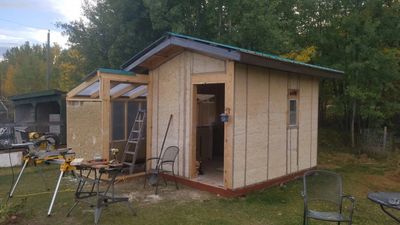hempcrete - regional appropriateness and best practice

Regionally appropriate building materials
Hempcrete is gaining popularity as a building material, primarily used as an insulation in framed walls. It makes a lot of sense as a local building material, and can be challenging to source if there isn't a local supplier. If you are considering hempcrete we can help with best practice and code alignment, so you have a safe and healthy home.
WHY hempcrete?
Basically a simple mixture of hemp hurds and a lime-based binder, a hempcrete mix can be poured and tamped into a wall cavity, fitting around framing and providing a monolithic/continuous insulation in the walls. The walls need a controlled cure/dry that balances the removal of moisture added during mixing with the needs of the lime to get a good 'set'. With a good initial cure/dry, and a properly matched finishing coat of plaster or similar, the walls will act as a vapour-open assembly, managing humidity and indoor air quality while also being highly insulative, anti-fungal/mold/bacteria, and highly fire-resistant.
Critical considerations:
- Getting a good initial set/dry that isn't too fast (hot/dry conditions that flash cure to a weak set) or too slow (inability to dry, leading to mold).
- Considering wet-weight of hempcrete when initially poured (at ~ 65% moisture content).
- Balancing hempcrete with thermal mass components (slabs, floors, etc) or passive solar design to avoid overheating in summer, and heat loss in winter.
- Moisture detailing and finishing coats to minimize dust and damage.
- Mouse protection so they don't get in the wall and crumble the hempcrete looking for seeds/food.
- Understanding the Effective R-value of hempcrete so as not to overspeed wall thickness.
Insulation Dominant & Thermal Mass Properties
Here in Canada with our cold climate, hempcrete acts primarily as an insulation. The vapour open properties (primarily due to lime) means it will take in water vapour from the air and store it within the wall - a humidity 'battery'. Humidity control is an extremely valuable property in cold climates.
Hempcrete thermal mass properties come from humidity stores in the hempcrete itself - a continuously changing moisture content. If the wall has achieved the critical first cure/set, it will excel at moisture storage, and it is this storage of moisture that gives hempcrete its thermal mass properties - keeps homes comfortable and cool in the summer, and comfortable and warm in the winter.
Code-approval
Hempcrete is an excellent option for homes and structures, especially those designed using passive-solar principles, and those looking to be highly energy efficient with a healthy indoor environment. Code approval as an alternate-solution is the most common route, and we can help you by working with your local building authorities to make it happen.
Consulting and Workshops
Contact us to discuss our consulting services, and keep an eye on our workshop page for hands-on learning opportunities!

AAC - ThE future of building in canada
AAC - Autoclaved Aerated Concrete
AAC is a mixture of cement, find sand, water, and foam. It's 75% lighter than concrete and the majority of the ingredient are of natural rare materials: sand, lime, water. By-products of production and fully recycled back into the production process. AAC does not contain aggregates, has high thermal insulation, is fast and efficient to build with, and is virtually fire-proof.
WHY AAC?
Until recently AAC couldn't compete with the stick framing industry, and despite being in major use around the world since the 1920's, gained little ground in Canada. AAC is exceptionally versatile - it comes in blocks, panels (including floor and roof panels), cladding, and more. It's high load-bearing capacity can eliminate lumber usage in wall construction completely.
SUSTAINABLE & FAST CONSTRUCTION
AAC is the next step in quick, cost effective, high performance, and sustainable construction. It is the step we need to reduce lumber and concrete usage in our built environment. It can be combined with carbon-negative insulation materials like hempcrete to provide healthy indoor environments. It is the TOP solution for fire-proof homes.
COMMERCIAL TOO
Multi-level, large scale, high performance - multi-level, large scale options.
Photo Gallery






This website uses cookies.
We use cookies to analyze website traffic and optimize your website experience. By accepting our use of cookies, your data will be aggregated with all other user data.